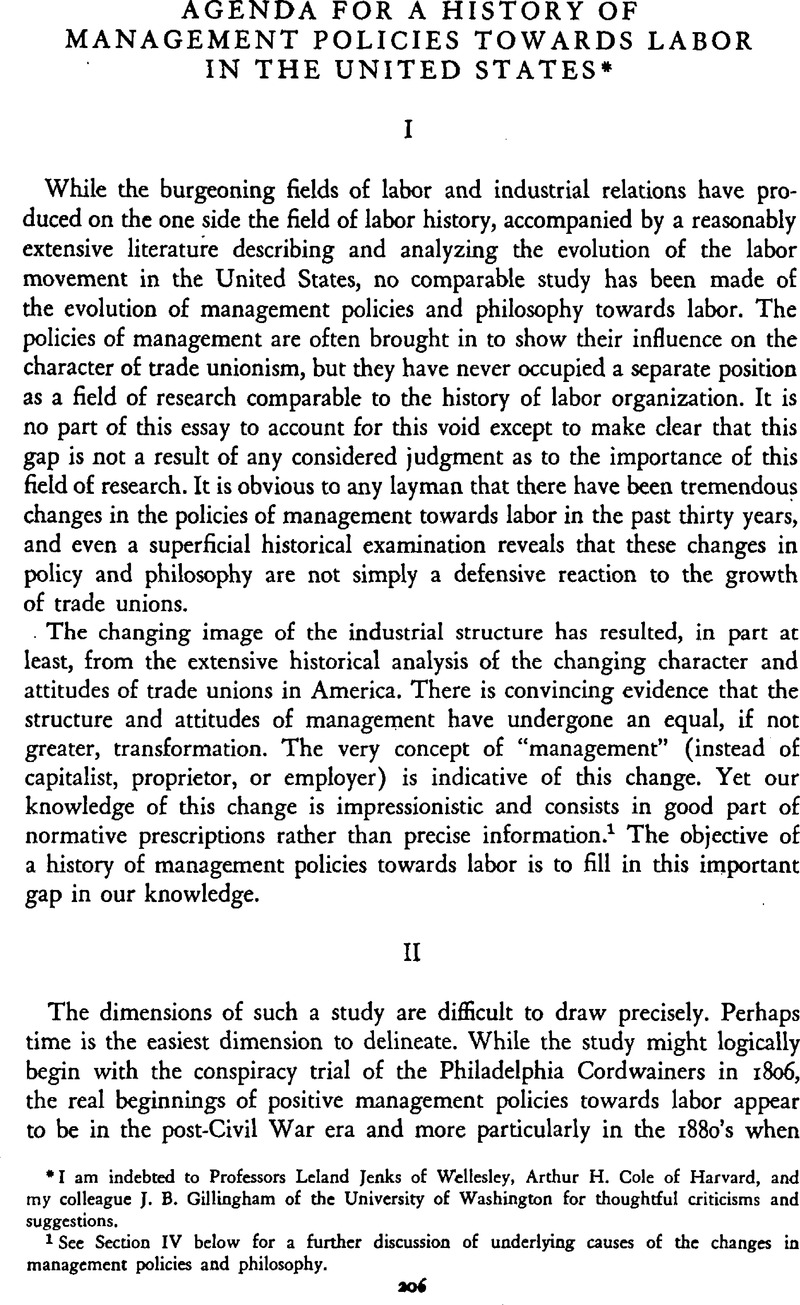No CrossRef data available.
Article contents
Agenda For A History Of Management Policies Towards Labor In The United States*
Published online by Cambridge University Press: 03 February 2011
Abstract

- Type
- Notes and Review Article
- Information
- Copyright
- Copyright © The Economic History Association 1956
References
1 See Section IV below for a further discussion of underlying causes of the changes in management policies and philosophy.
2 See Bonnett, Clarence E., Employer Associations in the United States (New York: The Macmillan Company, 1922)Google Scholar. It is possible, and indeed likely, that research will reveal the fact that a number of positive management policies had roots well back in the nineteenth century. In such a case, it would be useful to push back the starting time of the study.
3 Therefore the vast literature that has developed in the field of personnel administration is pertinent only to the degree that the administrative techniques illumine the evolving policies of management toward labor.
4 Willoughby, W. F., “Employer Associations for Dealing, with Labor in the United States,” Quarterly Journal of Economics, XX (November 1905), 110–50CrossRefGoogle Scholar.
5 The study of C. E. Bonnett, Employer Associations in the United States, contains an excellent discussion of these associations.
6 See Taylor, F. W., Shop Management (Norwood, Mass: The Plimpton Press, 1911)Google Scholar.
7 Actually union membership declined substantially from 1920 to 1923 and remained almost stationary for the rest of the decade. An excellent summary account of the 1920's may be found in Millis, Harry A. and Montgomery, Royal, Organized Labor (New York: McGraw-Hill and Co., 1945), Vol. IIIGoogle Scholar, chapter iv.
8 See Gordon, R. A., Business Leadership in the Large Corporation (Washington, D.C.: The Brookings Institution, 1945), pp. 95–96Google Scholar.
9 The terms are those of Harbison, and Coleman, in Goals and Strategy in Collective Bargaining (New York: Harper & Bros, 1951)Google Scholar.
10 See Carpenter, Jesse T., Employer's Associations and Collective Bargaining in New York City (Ithaca, N.Y.: The Cornell University Press, 1950)Google Scholar, and Kerr, Clark and Fisher, Lloyd, “Multiple Employer Bargaining: The San Francisco Experience,” Insights into Labor Issues, edited by Lester, Richard and Shister, Joseph (New York: The Macmillan Co., 1948)Google Scholar.
11 Harbison and Coleman, Goals and Strategy in Collective Bargaining, chapter v.
12 See the study, Labor Management Relations in Mini City (Institute of Labor and Industrial Relations, University of Illinois, 1953), Vol. IGoogle Scholar, for an interesting account of changing social and political attitudes in a midwestern city in the 1930's.
13 See Sumner Slichter, “The Current Labor Policies of American Industries,” Quarterly Journal of Economics, XLIII (May 1929), 393–435, and Witte, Edwin E., “The Evolution of Managerial Ideas in Industrial Relations,” Bulletin 27, New York State School of Industrial Relations, 1953Google Scholar.
14 Berle, A. A. and Means, Gardiner, The Modern Corporation and Private Property (New York: The Macmillan Co., 1932)Google Scholar.
15 R. A. Gordon, Business Leadership in the Large Corporation.
16 Seymour Melman points out that the increase in administrative personnel per 100 workers (or compared to production workers) from 1899–1947 is not a function of increased size so much as it is connected with the addition of new functions carried out by administration personnel. Melman, Seymour, “The Rise of Administrative Overhead in the Manufacturing Industries of the United States, 1899–1947,” Oxford Economic Papers, Vol. 3, No. I (February 1951), 62–112CrossRefGoogle Scholar.
17 While the literature on the early history o£ management policies towards labor is sparse indeed, there has been a voluminous amount of work in the past several decades. See for example, Golden, Clinton and Parker, Virginia (editors), Causes of Industrial Peace (New York: Harper & Bros., 1949)Google Scholar, or the Twentieth Century Fund Study, How Collective Bargaining Worlds (New York: Twentieth Century Fund, 1942)Google Scholar.


